Books by Park Nobel
NEW BOOK
DESERT WISDOM/AGAVES and CACTI: CO2, Water, Climate Change
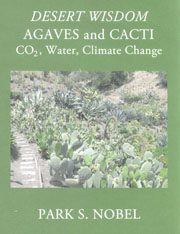 Agaves and cacti thrive under the warmer conditions,
variable rainfall, and increased CO2 characteristic of
global climate change. Moreover, their remarkable
biomass productivity promises multitudinous new uses in
addition to current uses ranging from tequila to
delicious fruits to fodder consumed by animals
worldwide. The book also discusses the water conserving
ability of agaves and cacti based on nocturnal opening
of stomata and hence nocturnal uptake of carbon dioxide,
a photosynthetic pathway referred to as Crassulacean
Acid Metabolism.
Agaves and cacti thrive under the warmer conditions,
variable rainfall, and increased CO2 characteristic of
global climate change. Moreover, their remarkable
biomass productivity promises multitudinous new uses in
addition to current uses ranging from tequila to
delicious fruits to fodder consumed by animals
worldwide. The book also discusses the water conserving
ability of agaves and cacti based on nocturnal opening
of stomata and hence nocturnal uptake of carbon dioxide,
a photosynthetic pathway referred to as Crassulacean
Acid Metabolism.
Now available in Spanish as Sabiduría del Desierto, Agaves y Cactos: CO2, agua, cambio climático (Biblioteca Básica de Agricultura, Mexico City).
table of contents | preface | excerpts | audiences | comments | announcements/reviews | ordering information
Books on Agaves and Cacti
The Cactus Primer (with Dr. Art Gison) (1986)
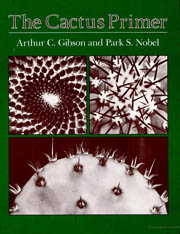 The Cactus Primer presents the amateur cactophile with an
excellent introduction to cactus biology and provides the informed
reader with an invaluable summary of the last forty years'
research. This book goes far beyond books that instruct readers in
the propagation, growth, and care of these plants; addressing
matters of more scientific interest, it takes an integrated
approach to the presentation of the form, physiology, evolution,
and ecology of cacti. The book is unique in that it combines the
descriptive morphology and physiology documented in the scientific
literature with more general observations found in popular
publications on cacti. It provides a new generic classification of
the cacti and contains much new information, including data on
photosynthesis, heat and cold tolerance, computer modeling of
ribs, and the effects of spines.
The Cactus Primer presents the amateur cactophile with an
excellent introduction to cactus biology and provides the informed
reader with an invaluable summary of the last forty years'
research. This book goes far beyond books that instruct readers in
the propagation, growth, and care of these plants; addressing
matters of more scientific interest, it takes an integrated
approach to the presentation of the form, physiology, evolution,
and ecology of cacti. The book is unique in that it combines the
descriptive morphology and physiology documented in the scientific
literature with more general observations found in popular
publications on cacti. It provides a new generic classification of
the cacti and contains much new information, including data on
photosynthesis, heat and cold tolerance, computer modeling of
ribs, and the effects of spines.
Enhanced by over 400 illustrations and supplemented with an extensive glossary, this book will appeal to cactus enthusiasts interested in the classification and growth of cacti, as well as to plant biologists who use cacti to illustrate desert adaptation and convergent evolution. Written in accessible style, The Cactus Primer is bound to serve a dual function as both an instructive tool and a reference work in cactus biology for years to come.
http://www.hup.harvard.edu/catalog/GIBCAC.html
Environmental Biology of Agaves and Cacti (1988)
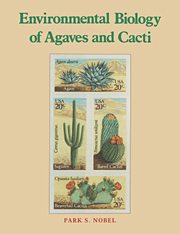 The Environmental Biology of Agaves and Cacti
constitutes the first comprehensive review of how these
two interesting and economically important desert
succulent taxa respond, in what turn out to be
remarkably similar ways, to specific environmental
factors such as water, temperature, photosynthetically
active radiation, and nutrients, which affect the
exchange of carbon dioxide and water vapor with the
environment. Park Nobel first summarizes early
environmental research as well as the many
ethnobotanical uses of agaves and cacti. He then
develops the main themes by considering the three most
studied species in detail. Much of the relevant research
has been carried out in his own laboratory since the
mid-1970s. The book's clear style, many photographs and
line drawings, and comprehensive data summaries make it
accessible to professionals and interested laypeople
alike. Every scientific term is defined the first time
it is used. Agaves and cacti are shown to be highly
productive compared to other plant groups, and this
productivity helps account for their many uses for
beverages, food, and animal fodder. Plant ecologists and
physiologists, agronomists, environmental biologists,
modelers, ethnobotanists, students, amateur succulent
enthusiasts, and those responsible for land use and
agricultural policy in arid and semiarid regions will
all find this book an invaluable resource.
The Environmental Biology of Agaves and Cacti
constitutes the first comprehensive review of how these
two interesting and economically important desert
succulent taxa respond, in what turn out to be
remarkably similar ways, to specific environmental
factors such as water, temperature, photosynthetically
active radiation, and nutrients, which affect the
exchange of carbon dioxide and water vapor with the
environment. Park Nobel first summarizes early
environmental research as well as the many
ethnobotanical uses of agaves and cacti. He then
develops the main themes by considering the three most
studied species in detail. Much of the relevant research
has been carried out in his own laboratory since the
mid-1970s. The book's clear style, many photographs and
line drawings, and comprehensive data summaries make it
accessible to professionals and interested laypeople
alike. Every scientific term is defined the first time
it is used. Agaves and cacti are shown to be highly
productive compared to other plant groups, and this
productivity helps account for their many uses for
beverages, food, and animal fodder. Plant ecologists and
physiologists, agronomists, environmental biologists,
modelers, ethnobotanists, students, amateur succulent
enthusiasts, and those responsible for land use and
agricultural policy in arid and semiarid regions will
all find this book an invaluable resource.
http://www.cambridge.org/asia/catalogue/catalogue.asp?isbn=9780521543347
Remarkable Agaves and Cacti (1994)
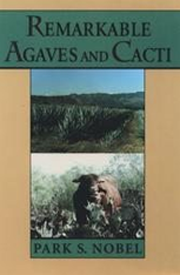 For at least 9000 years, agaves and
cacti have been cultivated and consumed by people the
world over. Whether they have been used to make
beverages, eaten as fruits, raised for their leaf
fibers, or fed to cattle, these succulent plants have
proven invaluable to the economies of many cultures.
This entertaining and informative book details the
unique characteristics and uses of the many species of
agaves and cacti. In his exploration of their past,
present, and potential future uses, Park S. Nobel--an
internationally known expert on the subject--explores
how agaves and cacti have served, for example, as
ornamental horticulture, as a key ingredient of tequila,
as hallucinogens in religious rites, and as medicines.
The author also considers the biology of agaves and
cacti by explaining how they are able to withstand the
harsh desert conditions in which they flourish, and by
describing at the cellular level their distinctive and
fascinating physiologies. Finally, the book makes the
case that these plants have exceptional potential for
mass cultivation and utilization in the future.
Succulent plant enthusiasts, amateur botanists,
interested laypersons, researchers, and professionals
alike will want to read this authoritative, popularly
written introduction to these unusually interesting
plants.
For at least 9000 years, agaves and
cacti have been cultivated and consumed by people the
world over. Whether they have been used to make
beverages, eaten as fruits, raised for their leaf
fibers, or fed to cattle, these succulent plants have
proven invaluable to the economies of many cultures.
This entertaining and informative book details the
unique characteristics and uses of the many species of
agaves and cacti. In his exploration of their past,
present, and potential future uses, Park S. Nobel--an
internationally known expert on the subject--explores
how agaves and cacti have served, for example, as
ornamental horticulture, as a key ingredient of tequila,
as hallucinogens in religious rites, and as medicines.
The author also considers the biology of agaves and
cacti by explaining how they are able to withstand the
harsh desert conditions in which they flourish, and by
describing at the cellular level their distinctive and
fascinating physiologies. Finally, the book makes the
case that these plants have exceptional potential for
mass cultivation and utilization in the future.
Succulent plant enthusiasts, amateur botanists,
interested laypersons, researchers, and professionals
alike will want to read this authoritative, popularly
written introduction to these unusually interesting
plants.
Out of print at Oxford University Press.
Cacti Biology and Uses (2002)
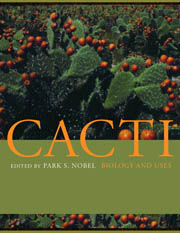 The Cactaceae family, with about sixteen hundred species, is cultivated
worldwide for fruits, forage, fodder, and even as a vegetable. Cacti are
recognized for their attractive flowers, special stem shapes, and
ability to tolerate drought. Because of their efficient use of water and
other adaptations, biological and agronomic interest in cacti has
soared. These fascinating plants also have much to teach us about
biodiversity and conservation. Yet a current, synthetic, wide-ranging
reference on cacti has not been available until now. This comprehensive
book, compiled by a well-known cactus biologist, includes authoritative,
up-to-date chapters by thirty-five contributors from around the world on
topics ranging from evolution to biotechnology. It is the first book of
its kind to compile information on cactus biology, ecology, and uses in
one convenient place.
The Cactaceae family, with about sixteen hundred species, is cultivated
worldwide for fruits, forage, fodder, and even as a vegetable. Cacti are
recognized for their attractive flowers, special stem shapes, and
ability to tolerate drought. Because of their efficient use of water and
other adaptations, biological and agronomic interest in cacti has
soared. These fascinating plants also have much to teach us about
biodiversity and conservation. Yet a current, synthetic, wide-ranging
reference on cacti has not been available until now. This comprehensive
book, compiled by a well-known cactus biologist, includes authoritative,
up-to-date chapters by thirty-five contributors from around the world on
topics ranging from evolution to biotechnology. It is the first book of
its kind to compile information on cactus biology, ecology, and uses in
one convenient place.
The first half of the book provides a thorough overview of cactus biology and morphology and discusses the environmental and conservation issues that affect the plants. It includes a discussion of the evolution of the family, paying particular attention to new genetic and molecular approaches. The second half of the book focuses on the practical concerns of cultivating cacti, such as pest control and diseases, horticultural and forage applications, and techniques for agronomy. Other chapters cover the different markets for cacti and products that are made from them.
This unique volume will be a reliable and informative reference for ecologists and environmentalists, agriculturists, plant biologists, and anyone seriously interested in these remarkable plants.
http://www.ucpress.edu/books/pages/9139.phpTextbook
Physicochemical and Environmental Plant Physiology, Fourth Edition (2009)
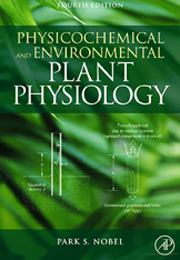 The new edition of Physicochemical and
Environmental Plant Physiology uses elementary
chemistry, physics, and mathematics to explain
and develop key concepts in plant physiology. In
fundamental ways, all physiological processes
that occur in cells, tissues, organs, and
organisms obey such relations. Topics include
diffusion, membranes, water relations, ion
transport, photochemistry, bioenergetics of
energy conversion, photosynthesis, environmental
influences on plant temperature, and gas
exchange for leaves and whole plants. This new
edition maintains the unparalleled commitment to
clear presentation and improves upon the user
friendliness of the previous versions.
The new edition of Physicochemical and
Environmental Plant Physiology uses elementary
chemistry, physics, and mathematics to explain
and develop key concepts in plant physiology. In
fundamental ways, all physiological processes
that occur in cells, tissues, organs, and
organisms obey such relations. Topics include
diffusion, membranes, water relations, ion
transport, photochemistry, bioenergetics of
energy conversion, photosynthesis, environmental
influences on plant temperature, and gas
exchange for leaves and whole plants. This new
edition maintains the unparalleled commitment to
clear presentation and improves upon the user
friendliness of the previous versions.
Many illustrations have been redrawn and over 20 new ones are added. Material has been updated throughout based on new research and special applications. Literally thousands of comments from students have led to substantial improvements. Other improvements have come from questions asked by colleagues from around the world. The result is not only a better textbook but also an increasingly valuable reference work. In summary, the 4th edition of Physicochemical and Environmental Plant Physiology is more comprehensive, more dynamic, and better illustrated while maintaining the clarity and incisiveness for which the series (seven versions beginning in 1970) is universally acclaimed.
http://www.elsevierdirect.com/product.jsp?lid=0&iid=5&sid=0&isbn=9780123741431
Note: The much revised Fifth Edition of Physicochemical and Environmental Plant Physiology (Academic Press, an imprint of Elsevier; ISBN 978-0-12-819146-0) is 654 pages long, weighs over 3 pounds, and appeared in early 2020. This is 50 years after the first book in the series!
All of these books can also be ordered from Amazon and Barnes and Noble